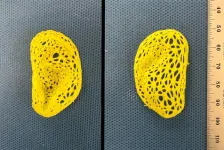(Press-News.org) Previous smallpox vaccination contributes significantly to higher neutralising antibodies following first MVA-BN dose
**Note: the release below is a special early release from the European Congress of Clinical Microbiology and Infectious Diseases (ECCMID 2024, Barcelona, Spain, 27-30 April). Please credit the congress if you use this story**
New research to be presented at this year’s European Congress of Clinical Microbiology and Infectious Diseases (ECCMID 2024) in Barcelona, Spain (27-30 April) shows that even in men who receives two doses of mpox vaccine intradermally, their level of antibodies to the virus falls to low or zero within the first few months if they have not received a previous smallpox vaccine.
The authors, who include Dr Klara Sonden, deputy state epidemiologist of the of Public Health Agency of Sweden and affiliated to Karolinska Institute, Stockholm, Sweden, says that their study shows that booster vaccination may be needed long-term for such individuals, and that scientific evidence is needed for the background to any decisions.
Since May 2022, an mpox outbreak has emerged globally, spreading mainly among men who have sex with men (MSM). It was classified as a Public Health Emergency of International Concern (PHEIC). In Sweden, a vaccine against smallpox based on the live Modified Vaccinia Virus Ankara (MVA-BN), has been offered intradermally to risk groups. Intradermal administration means 0.1 ml in the skin, one fifth of the dose needed for subcutaneous administration. This was used as a dose-saving strategy as supplies were initially limited.
The vaccine has been shown to be efficacious in studies using real-world data from the 2022 and onward outbreak among MSM, with limited number of breakthrough infections and milder disease reported when breakthrough infections occur so far. The aim of this cohort study was to assess dynamics of, and factors affecting neutralising antibodies against mpox virus (MPXV) following MVA-BN vaccination.
A total of 100 MSM attending the sexual health clinic “Venhälsan”, Stockholm, Sweden, eligible to receive the vaccine MVA-BN were included in the study. Following the initial serum sample drawn before dose 1, serum samples were further collected before dose 2, and 28 days and three months after the second dose. These samples were tested to establish titers (levels) of MPXV-neutralising antibodies. Titers were compared in individuals with or without previous smallpox vaccination and patients with past natural infection were included as positive controls.
10 individuals were of uncertain status regarding smallpox vaccination (due to being born in many different countries in the time period 1977-1980 when vaccination was de-escalated globally) and 23 individuals were previously smallpox vaccinated. The other 67 individuals had no history of smallpox vaccination.
A total of 312 samples from four time points from the 100 individuals included in the study were analysed. In addition to the study population, anonymised age and sex matched controls from blood donors were included as negative controls (n=20) and previously MPXV-infected individuals as positive controls (n=20). The controls gave one blood sample each.
Within the study group, previous smallpox vaccination was associated with significantly higher antibody titers, and 15/23 of these individuals had pre-existing neutralising antibodies (ie, the B-cell memory was still present thanks to their previous smallpox vaccination).
Among those without prior smallpox vaccination, fewer than half of the group showed any detectable neutralizing antibodies at all 28 days after the second vaccination, with those who did exhibit responses having a median titer (standard unit of measurement of antibodies) of 20. In contrast, for previously vaccinated individuals, the median titer 28 days after a single dose of the MVA-BN vaccine was 40.
The authors say: “Our findings corroborate other studies showing that mpox vaccination results in neutralising antibodies only in a proportion of vaccinees, and that a significant decline occurs already during the first month post-vaccination Immunity after previous MPXV infection mounts a higher and more robust neutralising response. In conclusion, the findings merits the study of booster doses.”
They continue: “Our results indicate a rapid decline in neutralising antibodies after two doses and are in line with other recent studies. These results, together with the continued spread of mpox in MSM populations in Europe has prompted the consideration of a booster dose. Such a recommendation needs to be based on scientific evidence. However, as far as we know, no clinical trial has studied or is studying a 3rd MVA-BN dose (from an analysis of clinicaltrials.gov March 2024), but a booster dose is common practice for inactivated vaccines. The MVA-BN is a live, non-replicating vaccine and therefore likely equivalent to an inactivated vaccine. Studies are essential to inform public health policy, and the largest STI clinic in Sweden is planning to perform a randomised clinical trial of a booster dose with immunological parameters as the primary outcome in the comparison with those who have had the two doses of the regular full 0.5 subcutaneous dose (sc) (0.5ml), two doses of the dose-saving intradermal dose (id) (0.1ml), or one dose sc/one dose id, and those with no booster dose.”
They add that despite this, the Mpox cases in Sweden have been few and mostly imported during 2023 (12 cases) and 2024 (5 cases) and the vast majority have been among unvaccinated individuals. Data collection is ongoing regarding the occurrence of breakthrough infections in Sweden. Breakthrough cases have been reported in the scientific literature among individuals that have received different vaccination strategies (i.e. sc/sc, id/sc, id/id) (Hazra et al)*.
Dr Sonden concludes: “The results presented here indicate that long-term protective immunity might need a booster dose for its maintenance. Since the current situation regarding mpox in Sweden is stable with minimal transmission any change in policy should be backed by results from clinical trials. Currently we will focus on finding unvaccinated individuals who are at risk of getting mpox and offer them vaccination, and we believe that this as well as the previously administered vaccinations will contribute to lowering the risk for new outbreaks of mpox in Sweden in future.”
END
New research to be presented at this year’s European Congress of Clinical Microbiology and Infectious Diseases (ECCMID 2024) in Barcelona, Spain (27-30 April) shows that the antibodies produced by Modified Vaccinia virus Ankara - Bavarian Nordic (MVA-BN) vaccination against mpox wane significantly within a year of receiving the vaccination – but in people with pre-existing immunity due to childhood smallpox vaccination in childhood, antibody levels remain high in almost all cases. The study is presented by PhD student Dr. Marc Shamier, Erasmus MC, Rotterdam, Netherlands, from a research team led by Dr Rory de Vries.
During the 2022-2023 ...
New research to be presented at this year’s European Congress of Clinical Microbiology and Infectious Diseases (ECCMID 2024) in Barcelona, Spain (27-30 April) details the case of a man who had received two doses of the monkey pox vaccine in Autumn, 2022 yet experienced a ‘breakthrough’ mpox infection in January 2024. The authors believe breakthrough should be considered in fully vaccinated individuals engaging in high-risk behaviors. They also call for further research on the need for booster ...
Researchers from Lund University in Sweden have identified distinct molecular signatures associated with the clinical signs of sepsis that could provide more accurate diagnosis and prognosis of sepsis, as well as help to target specific therapies at patients who would benefit most, according to new research being presented at this year’s European Congress of Clinical Microbiology and Infectious Diseases (ECCMID 2024) in Barcelona, Spain (27-30 April).
“A simple blood test when combined with a personalised risk model has the potential to save lives by providing more accurate sepsis diagnosis and determining who may go on to develop more severe clinical ...
*This is an early press release from the European Congress on Obesity (ECO 2024) Venice 12-15 May. Please credit the Congress if using this material*
New research being presented at this year’s European Congress on Obesity (ECO) in Venice, Italy (12-15 May), identifies the optimum body weight range for adults with type 2 diabetes to minimise their risk of dying from any cardiovascular disease, including heart failure, heart disease, stroke, and chronic kidney disease.
The findings, based on health data from the UK Biobank, indicate that for adults aged 65 years or younger, maintaining a body mass index (BMI) within the normal range of 23–25 kg/m² was associated with the ...
Waltham — March 29, 2024 — Parents voice strong concerns about social media sharing of images of children undergoing craniofacial surgery, reports a survey study in the April issue of Plastic and Reconstructive Surgery®, the official medical journal of the American Society of Plastic Surgeons (ASPS). The journal is published in the Lippincott portfolio by Wolters Kluwer.
"Pediatric plastic surgeons must understand that consent and assent are necessary before posting patient images online," comments senior author Kenneth L. Fan, MD, of Georgetown ...
Researchers Produce Grafts that Replicate the Human Ear
Using state-of-the-art tissue engineering techniques and a 3D printer, researchers at Weill Cornell Medicine and Cornell Engineering have assembled a replica of an adult human ear that looks and feels natural. The study, published online in Acta Biomaterialia on March 16, offers the promise of grafts with well-defined anatomy and the correct biomechanical properties for those who are born with a congenital malformation or who lose an ear later in life.
“Ear reconstruction requires multiple surgeries and an incredible amount of artistry ...
BOSTON, United States — 29 March, 2024 — Based on the success of its 2023 HF-GRO program effort, Hevolution Foundation is issuing a call for applications for the 2024 iteration of the program. HF-GRO is an international effort to accelerate progress in healthy aging research. The major goal is to identify and support research that will further the Hevolution’s mission of extending healthy lifespan for the benefit of all humanity.
HF-GRO will ...
HOUSTON – (March 29, 2024) – Gas vesicles are hollow structures made of protein found in the cells of certain microorganisms, and researchers at Rice University believe they can be programmed for use in biomedical applications.
“Inside cells, gas vesicles are packed in a beautiful honeycomb pattern. How this pattern is formed has never been thoroughly understood. We are presenting the first identification of a protein that can regulate this patterning, and we believe this will be a milestone in molecular microbiology,” said George Lu, assistant professor of bioengineering and a Cancer Prevention and Research Institute of Texas scholar.
Lu and colleagues have published ...
Alexandria, VA – The American Association for Dental, Oral, and Craniofacial Research (AADOCR) has named the recipients of the 2024 Student Competition for Advancing Dental Research Application (SCADA). The recipients were recognized during the Opening Ceremonies of the 53rd Annual Meeting of the AADOCR, which was held in conjunction with the 102nd General Session of the International Association for Dental, Oral, and Craniofacial Research and the 48th Annual Meeting of the Canadian Association for Dental Research, on March 13-16, 2024 in New Orleans, LA.
The winners are:
CLINICAL RESEARCH & PUBLIC HEALTH CATEGORY
1st ...
AURORA, Colo. (March 29, 2024) –Researchers at the University of Colorado Anschutz Medical Campus and collaborators across the country have conducted the largest and most diverse study of men with extra X or Y chromosomes in the US using a large dataset of military veterans. The results could lead to better diagnoses of these underrecognized conditions and earlier treatment of associated diseases.
The study was published today in JAMA Network Open.
“One in 400 males have an additional X or Y chromosome, however 86 percent of these individuals are not diagnosed,” said ...


